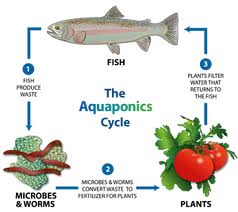
19 Mar ECOACTION PARTNERS: GROWING POWER FOR A POWERFUL FUTURE

Aquaponics cycle
We know that the cities are now home to more of us than the country. We know that water issues, particularly here in the West will define much of our future. We know that the current carbon footprint of our food leaves much to be desired – as does the quality when the food on the average dinner plate has traveled 1500-2000 miles to get there.
Is there another way? Of course – many in fact.
One way, new to me but gaining in popularity quickly, is the art and science of aquaponics.
At the most recent Telluride Town Council meeting the concept of an aquaponics greenhouse in Telluride was brought forward. While there were questions about potential sites, the idea itself seemed to have unanimous support. We do, after all, import 100% of our food into our dear little valley. That makes us extremely vulnerable to having that food supply interrupted. While one aquaponic greenhouses (even several) won’t completely supply the town with food, putting this system in place would help that carbon footprint – and would be something very cool for locals and visitors alike to be a part of.
To help that all come about, I have spent the last few days in Milwaukee, Wisconsin at Growing Power’s world headquarters. It is an amazing place and a growing – ahem, pun intended – idea.

Will Allen on site at Growing Power
The whole thing got started and continues to be directed by Will Allen. Will was a professional basketball player, marketer for Proctor & Gamble, and someone who grew up growing food. Growing Power is a non-profit with goals of growing food, growing minds, and growing community. Will started the journey that led him to Growing Power when he found land in the city with some abandoned greenhouses on site. He took this site under his incredibly green thumb and created an astounding world under plastic for the community. Eight solid greenhouses and seven plus hoop houses part the drifts and create a warm and wonderful growing and learning environment.
Growing Power hosts workshops every month – one in aquaponics and another that offers participants their choice of topics: mycoscaping (mushrooms), year-round greenhouse production (microgreens), compost and vermicompost, hoop house construction, community project planning, renewable energy and beekeeping. If you know me, you can understand why I felt right at home.
Aquaponics – though not new to humans (think of the Hanging Gardens of Babylon) – is undergoing rapid transformation and growth. It involves raising fish for food and using the fish’s water to grow plants in a mostly closed loop system. That may sound simple enough, but to see the systems in person and begin to pick apart the pieces was fascinating. It takes one growing surface in a greenhouse and turns it into three simultaneously productive spaces.
We spent the first few hours touring the site. From thousands of trays in various stages of microgreens production to the hanging bag mushroom factories, Will’s place was pure delight. One greenhouse and a hoop house or two are devoted to composting and creating soil – the heart of the system. Four greenhouses have a variety of aquaponic systems and one newer greenhouse is about to have an intensive research project comparing four types of aquaponic systems in a rigorous study with the University of Wisconsin Milwaukee School of Freshwater Sciences. In the Growing Power system they are switching from tilapia, a fish that is relatively easy to grow, to raising yellow perch, which is more demanding, but also in higher demand and native to the region.
The fish are grown in tanks, fed and monitored regularly from a platform of vast knowledge about both fish, methods of moving water, and water chemistry needed. The water from the fish tanks is pumped up to the top level of the plant growing bed. Here plants like watercress, nasturtiums, mint and a host of other vegetables in pots are grown. The plants’ roots extend into the flowing water and extract nutrition from the fish wastes – and in the process clean the water. Each growing bed is on a slight slant and at the end of the uppermost bed the water drains down into a second tier of plant beds. That gives a grower a large surface area for growing and frequently harvesting plants with a high value fish harvest after about a year.
Of course, there’s a lot more to it than that, but the workshop gave us enough information and exposure to small scale aquaponics for us all to have the confidence to create at least a small system. Some participants already had their aquaponics underway, while most were either about to embark on a system or just wanting to learn more. It was an incredibly diverse group and completely heartening to hear all the wonderful things being done – and planned.
Check out Growing Power at www.growingpower.org or catch me on the street to learn more.


Sorry, the comment form is closed at this time.